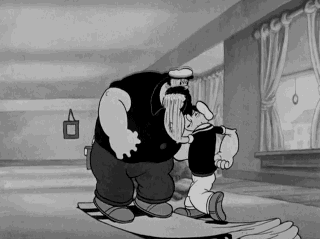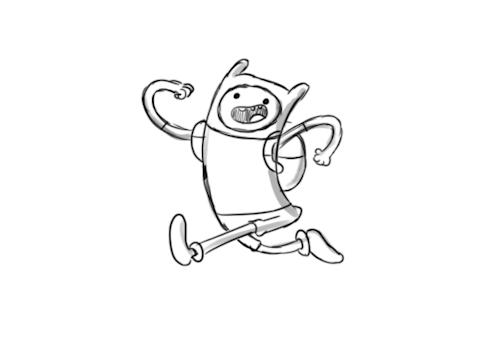1) Squash and Stretch: Allows the animator to give the illusion of weight by emphasising the squash and stretch of a movement.
An example of squash and stretch in action.
For Example: The Pixar logo with the lamp is a good example of this principle put to use in a 3D context, as the lamp squashes and stretches as it animates, giving it weight, volume and character all of it's own.
2) Anticipation: The movement that a character or object makes before an action.
Anticipation > Action > Reaction
For Example: 0:59 When Tom swings the golf club, this is a perfect example of anticipation in animation as the wind up is emphasised before the resulting action.
For Example: The Simpsons often has good staging, with a diverse range of camera angles in which the characters facial expressions are always visible and mannerisms clear and concise thanks to their positioning in the scene.
4) Straight Ahead and Pose-to-pose Animation:
Straight Ahead Animation: the process of animating frame after frame without the use of Key-framing. If you're not careful you can wander off and lose a sense of scale, volume and balance.
For Example: Less emphasis on timing makes it harder for large teams of people to work together meaning Straight Ahead Animation is more suited to solo animators at specific moments in a scene. An example of this would be some of the more exaggerated walk cycles in cartoons such as Ren and Stimpy.
Pose-to-pose: meticulously planned. The animator works out what key poses will be needed ahead of time. An assistant then draws the in-between frames. Pose-to-pose animation allows for a more collaborative process and more control over timing and movement.
For Example: Most forms of traditional 2D animation use this technique as it allows for large teams of people to work together on a single project within a manageable space of time.
5) Follow through and overlapping action: actions that happen after the main action has stopped or an object has changed direction.
For Example: Spike, the dog from Tom and Jerry is a prime example of this in the way the skin fat on his face moves and overlaps when he moves.
6) Slow-Out and Slow-In (Ease-in, Ease-out): Variation in the number of frames at different stages of an action.
Fewer Drawings > Faster Action
More Drawings> Slower Action
For Example: Popeye's punches are probably the best example I can think of a circular arc in a piece of animation. Movements are natural, well timed and follow a circular path, making the animation flow more fluently.
8) Secondary Action: An action that reinforces the intentions of the first. (Not to be confused with overlapping action.)
For Example: During a walk cycle, often the characters arms will swing or facial expression will change mid-stride to reinforce the primary action. In this specific cycle, Finn's backpack moving on his back is the secondary action.
For Example:
10) Exaggeration: not just about being bigger, faster etc. More subtle exaggeration is more effective in some cases.
For Example: There are examples of exaggeration being put to good use throughout Ren and Stimpy, for example: when Stimpy is looking through the hole in the garden fence and his eye becomes detached and comically elongated.
11) Solid Drawing: The basic principles of drawing form, weight and volume to give the illusion of fully three dimensional characters. Good solid drawing has depth and balance.
For Example: Characters in The Simpsons are well modelled and follow a consistent volume across a variety of shots and camera angles.
12) Appeal: The design must be aesthetically pleasing and able to clearly communicate the intended message to the audience. Every character must be visually appealing in some way or another with an interesting personality present in their design.
For Example: The surrealist character designs of The Regular Show are appealing due to their absurdity.







No comments:
Post a Comment